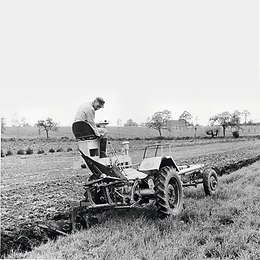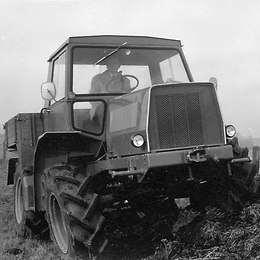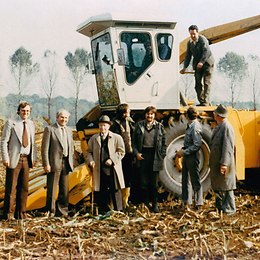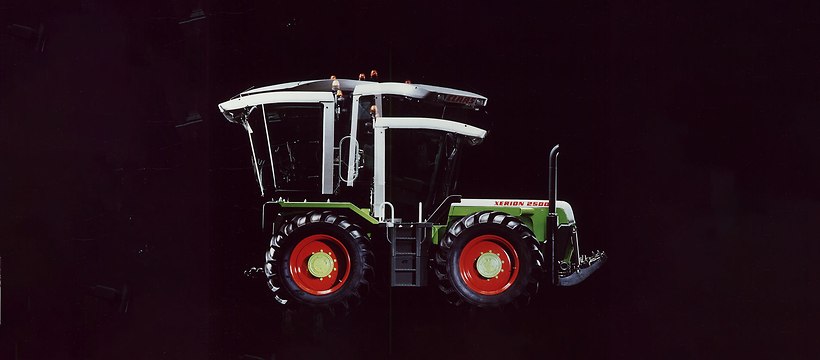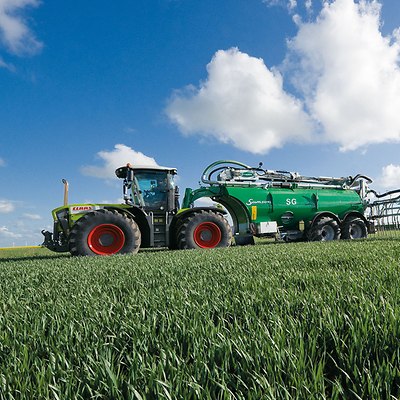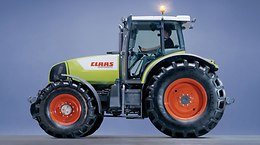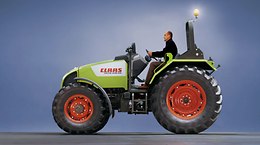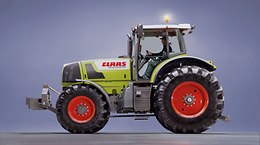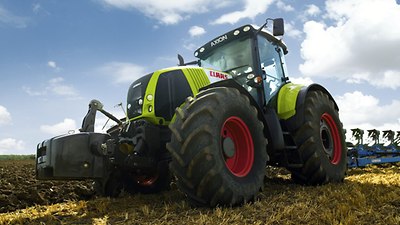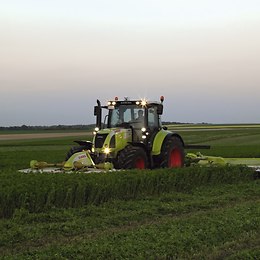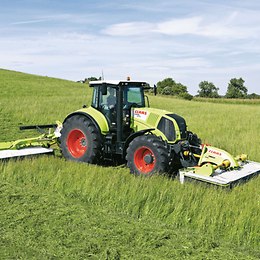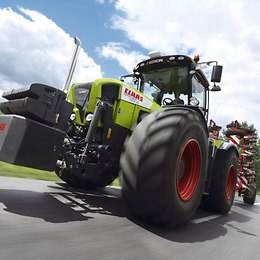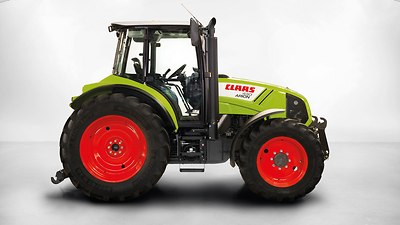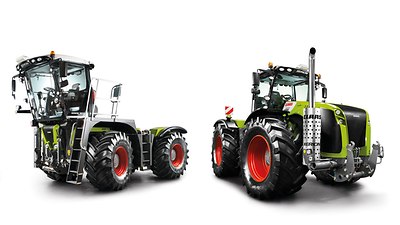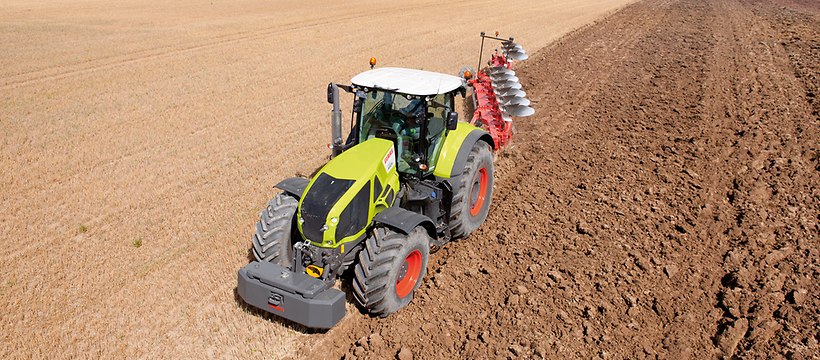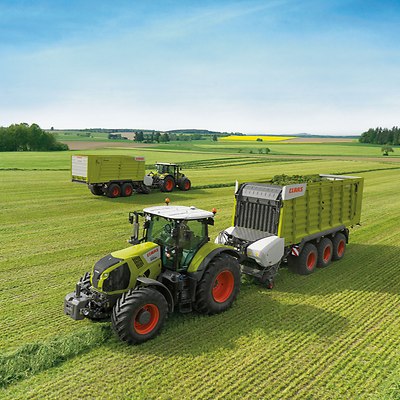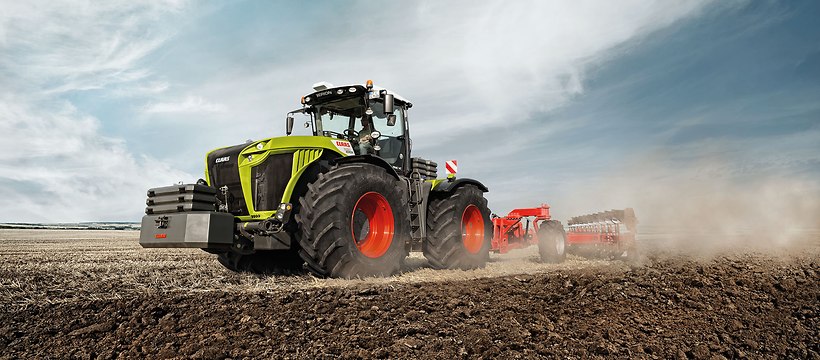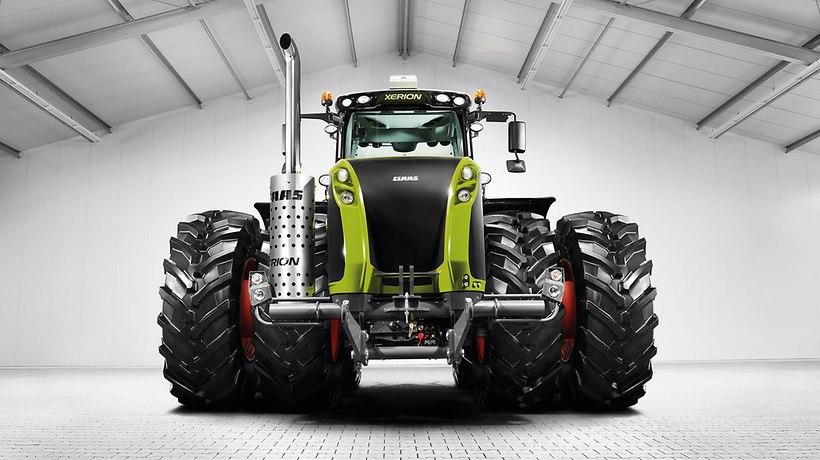

The tractor introduces a new corporate dimension
August Claas had developed and marketed a tractor-like device back in the late 1950s. In 1978, work started on the development of a large tractor with infinitely variable drive – the XERION. But it was the purchase of Renault’s tractor division in 2003 that made it possible to turn the firm’s longstanding dream of having its own tractor into a reality. CLAAS then lost no time in establishing a profile as a leading tractor manufacturer.
Pre-history
August Claas had already developed and marketed a tractor-like “carrier for a range of tools and implements” in 1957, called the “HUCKEPACK”. This was a self-propelled combine harvester, which could be converted into an implement carrier once the harvest was over. It was designed for use all year round, as the ultimate “all-purpose” machine, but it remained in production only until 1960.
At the end of the 1960s, CLAAS then took up the tractor idea again with the HSG project. The HSG was initially intended as an experimental vehicle for the development of a new hydrostatic transmission for combine harvesters (“Hydrostatisches Getriebe” in German, hence the abbreviation HSG), but it soon morphed into a project in its own right, as an entry ticket into the high-end tractor segment. CLAAS engineers had spent the four years from 1968 to 1972 making subtle modifications to a CLAAS tractor model, to be distributed in collaboration with Daimler-Benz and produced by CLAAS. However, the partnership did not proceed, and, as part of a savings programme at the time, the project had to be put on ice.
Yet the dream of a CLAAS tractor remained. In retrospect, the HSG can be seen as marking the beginning of the development of trac vehicles at CLAAS, an idea that was taken up again in 1978 with Project 207, which many years later became internationally established as the XERION large tractor series. The consistent application of the infinite variability concept since the very first XERION model in 1978 can be seen as pointing the way forward. But it is not just the technology of the XERION that makes it a firm favourite today; like no other product, it epitomises the realisation of an entrepreneur’s vision and unwavering belief in the concept of a trac vehicle with infinitely variable drive.
1993
The XERION large tractor was publicly unveiled in 1993. The XERION tractor, developed in-house by CLAAS engineers, combined the power and performance expected of a state-of-the-art tractor today with the required attributes for an agricultural system vehicle. The cab could be placed in three different positions, allowing a range of uses: as a normal tractor, with the cab in the centre, or as a system vehicle, with the cab rotatable 180° to the rear for system vehicle applications, central and off-centre positions. The adaptation devices available with the XERION also gave the vehicle a wide and diverse range of other uses. Another feature of the XERION was the HM-8 infinitely variable transmission, developed in-house by CLAAS, which was awarded the DLG gold medal at Agritechnica 1997.
2004
Upon its acquisition of a majority stake in Renault Agriculture in 2003, CLAAS was then in a position to add standard tractors to its product repertoire. In that same year, the former Renault tractor plant at Le Mans, France produced its first run of tractors in the CLAAS seed-green livery, which were duly presented to the public for the first time at Agritechnica. At that stage, the range of CLAAS tractors sporting the seed-green colour comprised four model series: the CELTIS, an all-rounder; the ARES premium tractor; the ATLES large tractor; and the XERION, as the top-of-the-range model, made in Harsewinkel.
In the reworked XERION 3300, CLAAS had a versatile tractor covering a wide range of uses, available in three different variants: firstly, the XERION TRAC, with 335 hp, infinitely variable ZF transmission, RABA steering axle, and electronic four-wheel steering with six steering programmes; secondly, the XERION TRAC VC, with the rotatable cab as its most distinctive feature; and thirdly, the XERION SADDLE TRAC, with fixed cab mounted on the front axles.
2006
The CLAAS AXION, available in five variants ranging from 163 hp to 260 hp, was the first tractor produced at the former Renault tractor plant to sport the seed-green livery from day one. Work on its development started at the end of 2003, soon after the tractor plant’s incorporation in the CLAAS family. The main development objectives for the new AXION were enhanced comfort and convenience for the user, a combination of high performance with low fuel consumption, and outstanding reliability.
The 6.8-litre six-cylinder DPS engine fitted in the CLAAS AXION met the TIER 3a exhaust standard, and also had lower fuel consumption than in the previous TIER 2 technology, thanks to the sophisticated engine design. CLAAS was therefore now able to offer a state-of-the-art tractor for large farming operations, contractors and machine syndicates.
2007
In the tractors segment, CLAAS unveiled the new ARION 500 and 600 model series at Agritechnica. CLAAS tractors now covered a wide power rating spectrum from 112 hp to 155 hp, meeting the varied requirements of customers on the international market. The power boost from CLAAS POWER MANAGEMENT gave the largest models, the ARION 540 and ARION 640, an extra 20 hp, to cope with even the very toughest jobs. The new ARION series were equipped with the user-friendly HEXASHIFT transmission, which automates range shifting and can be operated without a clutch. All ARION series models had a choice of 40 km/h or 50 km/h top speed, at a economical 1,900 rpm.
CLAAS AXION with infinitely variable CMATIC transmission variant. The AXION became available in five different model variants from 163 to 225 hp (120 to 165 kW ECE R24) and bridged the gap between the ARES 600 and the ATLES. The main components of the modern tractor were newly designed from the ground up. The machine was the first tractor to sport the seed-green livery from day one. Its development began in late 2003, when tractor production was being incorporated into the CLAAS family.
Introduction of the XERION 3800 large tractor. This 379-hp XERION model features the new CLAAS SEQUENCE MANAGEMENT automatic headlands control system, GPS-controlled steering and an ISOBUS connection, resulting in a consummate multifunctional performer. The proven rotatable cab (optional equipment) maintains the outstanding versatility of the vehicle.
2010
In 2010, CLAAS introduced a compact tractor model, the ARION 400. The new CLAAS compact range had six engine sizes, covering a power rating spectrum from 90 hp/66 kW to 125 hp/92 kW (according to ECE R24). The features and dimensions of the ARION 400 positioned it between the ARION 500 and the AXOS.
At Agrictechnica 2009, CLAAS unveiled two new XERION models, the 5000 and 4500, ready for the 2010 season. CLAAS already had the XERION 3800 and 3300 in the up to 400-hp class, and these two new models extended its range into the over 500-hp category.
2012
At Agritechnica 2011, the new AXION 950-920 model series celebrated its arrival by being awarded the “Machine of the Year” prize in the large tractors category. Four models in the 280–400-hp size category supplemented the by now well-known AXION 800 range, with 164 to 260 hp, and the XERION 3300 to 5000 models, with 330 to 530 hp. The AXION 900 was the first CLAAS tractor model to meet the requirements of the TIER 4 exhaust standard. The AXION 900 was also the first model to be fitted with CLAAS POWER SYSTEMS (CPS). CPS has continued to represent an optimum combination of leading-edge components and technologies in the drive train.
2013
With the new ARION 500/600 series, CLAAS was able to offer the technology and comfort attributes of CLAAS large tractors in the 140 to 184-hp power range. The four-cylinder models in the ARION 500 model series featured impressive versatility and power, particularly for PTO and front loader tasks. The six-cylinder models in the ARION 600 range offered superior pulling power and ultra-smooth running, both on the road and in the field.
The new CLAAS AXION 800 was also introduced for the first time. This was a completely new design, occupying the 200 to 270-hp power slot in the CLAAS tractor family. It was the first product from the Le Mans plant to have a Stage IV (Tier 4f) engine, successfully fulfilling all the exhaust gas purification requirements for the world of tomorrow.
In the new AXION 800, CLAAS continued to apply the successful basic concepts that were major milestones in the first 800 models: a compact construction with long wheelbase, and an extensive range of CIS and CEBIS equipment and operating features. In the first stage, the HEXASHIFT transmission was provided, to be followed some time later by the infinitely variable CMATIC transmission.
2014
With the introduction of the new XERION 5000-4000 range in 2014, CLAAS also met the rigorous requirements of the Stage IV (Tier 4) exhaust standard in its top-of-the-range class. Mercedes-Benz six-cylinder inline engines, with three power packages, provided all the power required. The new CLAAS models also featured improved driver comfort, with the new semi-active cab suspension. The dampers are electronically controlled, adapting the suspension automatically to the driving conditions at the time. And for the SADDLE TRAC model, also available as optional equipment is the new pivoting rear linkage, awarded the Agritechnica Silver Medal in 2013. This function is used to align the three-point hitched implements in crab steering mode in line with the direction of travel.
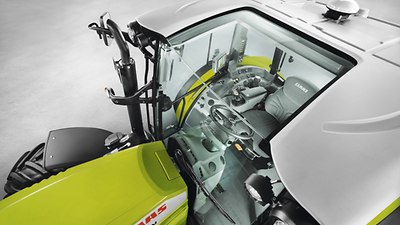
There were also some new arrivals in the 75 to 140-hp class of CLAAS tractors. The new tractors were designed for a wide and diverse spectrum of requirements, ranging from simple technology for routine tasks to automatic functions for intensive use. The new ELIOS 200, ATOS 200 / 300 and ARION 400 tractors offered cleverly designed equipment features focused on practical requirements, such as the PANORAMIC cab in the ARION, awarded the gold medal at SIMA in 2015. A 2.41-m2 full glass front from floor to ceiling, plus a glass roof, provide optimum visibility, ideal for working with the front loader.
2017
The extensively reworked AXION 900, AXION 800, ARION 600, 500 and 400 were re-launched in 2017. The AXION 960 with 445 hp is the new flagship model in the standard tractor range, and a new top-of-the-range ARION model was also introduced, with the ARION 660 with 205 hp.
CLAAS has very quickly established a profile as a leading tractor manufacturer. There is a choice of 50 models, from 75 to 530 hp: the XERION 4x4 large tractors, the AXION, ARION and ATOS standard tractors, ELIOS compact class and the NEXOS models in the narrow-track segment. This comprehensive range of outstanding products is precisely tailored to the requirements of the agricultural sector today.


